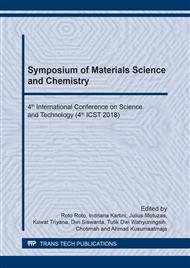[1]
O. Kirk, T.V. Borchert, C.C Fuglsang, Industrial enzyme applications, Curr. Opin. Biotechnol. 13 (2002) 345-351.
Google Scholar
[2]
M. Akimoto, Y. Nagashima, D. Sato, A kinetic study on lipase-catalyzed interesterification of soybean oil with oleic acid in a continuous packed bed reactor, J. Appl. Biochem. Biotechnol. 81 (1999) 131-142.
DOI: 10.1385/abab:81:2:131
Google Scholar
[3]
A. Pandey, S. Benjamin, C.R. Soccol, P. Nigam, N. Krieger, The realm of microbial lipases in biotechnology, Biotechnol. Appl. Biochem. 29 (1999) 119-131.
Google Scholar
[4]
R. Gupta, N. Gupta, N. Rathi, Bacterial lipases: An overview of production, purification and biochemical properties, J. Appl. Microbiol. Biotech. (2004) 763-781.
DOI: 10.1007/s00253-004-1568-8
Google Scholar
[5]
R. Aravindan, P. Anbumathi, R. T. Viruthagiri, Lipase applications in food industry, Indian J. Biotech. 6 (2004) 141-158.
Google Scholar
[6]
K.J. Patil, M.Z. Chopda, R.T. Mahajan, Lipase Biodiversity, Indian J. Sci. and Tech. (2011) 71-982.
Google Scholar
[7]
S.N. Ethica, Detection of Genes Involved in Glycerol Metabolism of Alcaligenes sp. JG3, Ph.D. Thesis, UGM, Yogyakarta, (2014).
Google Scholar
[8]
P. Lestari, S.N. Handayani, Oedjijono, Biochemical properties of crude extracellular lipase fromxAzospirillumxsp. JG3., Molekul 4 (2009) 73-82.
DOI: 10.20884/1.jm.2009.4.2.65
Google Scholar
[9]
B. Austin, C. Rodgers, J. Forns, R. Colwell, Alcaligenes faecalis subsp. homari subsp. nov., a new group of bacteria isolated from moribund lobsters, Int. J. Syst. Bacteriol. (1981) 72-76.
DOI: 10.1099/00207713-31-1-72
Google Scholar
[10]
Y. Xu, R. Xiao, Lipase from Genus Rhizopus: characteristics, expression, protein engineering and application, Prog. Lipid Res. 64 (2016) 57-68.
DOI: 10.1016/j.plipres.2016.08.001
Google Scholar
[11]
S.Y. An, S.W. Kim, Y.L. Choi, Y.S. Cho, W.H. Joo, Y.C. Lee, Cloning, expression in Escherichia coli and enzymatic properties of a lipase from Pseudomonas sp. SW-3, J. Microbiol. 41 (2003) 96-101.
Google Scholar
[12]
A.R. Cho, S.K. Yoo, E.J. Kim, Cloning, sequencing and expression in E.coli of thermophilic lipase from Bacillus thermoleovorans, Microbiol. Lett. 186 (2000) 235-238.
DOI: 10.1111/j.1574-6968.2000.tb09110.x
Google Scholar
[13]
D.N. Lang, W. Yang. Y. Wang, Y. Shen, B. Yang, A novel cold-active lipase from Candida albicans: cloning, expression and characterization of the recombinant enzyme, Int. J. Mol. Sci. 12 (2011) 3950-3965.
DOI: 10.3390/ijms12063950
Google Scholar
[14]
E.M. Zakary, M.Z. Naif, G.M.O. Mohammed, Detection of Staphylococcus aureus in bovine milk and its product by real-time PCR assay, J. Biotechnol. Biochem. 6 (2011) 171-177.
Google Scholar
[15]
S.N. Ethica, D.R. Nataningtyas, P. Lestari, Istini, E. Semiarti, J. Widada, T.J. Raharjo, Comparative evaluation of conventional versus rapid methods for amplifiable genomic DNA isolation of cultured Azospirillum sp. JG3, Indones. J. Chem. 13 (2013) 248-253.
DOI: 10.22146/ijc.21284
Google Scholar
[16]
J. Yang, Y. Zhang, Protein structure and function prediction using I-TASSER, Curr. Protoc. Bioinform. 52 (2015) 1-15.
Google Scholar
[17]
H. Akatsuka, E. Kawai, K. Omori, T. Shibatami, The three genes lipB, lipC and lipD involved in the extracellular secretion of the Serratia marcescens lipase which lacks an N-terminal signal peptide, J. Bacteriol. 177 (1995) 6381-6389.
DOI: 10.1128/jb.177.22.6381-6389.1995
Google Scholar
[18]
J.H. Ahn, J.G. Pan, J.S. Rhee, 1999. Identification of the triDEF ABC transporter specific for lipase in Pseudomonas fluorescens SIK W1, J. Bacteriol. 181 (1999) 1847-1852.
DOI: 10.1128/jb.181.6.1847-1852.1999
Google Scholar
[19]
F. Rosenau, K.E. Jaeger, Bacterial lipases from Pseudomonas: regulation of gene expression and mechanisms of secretion, Biochem. 82 (2000) 1023-1032.
DOI: 10.1016/s0300-9084(00)01182-2
Google Scholar
[20]
Y. Park, Y. Moon, J. Ryo, N. Kim, H. Cho, J. H. Ahn, Identification of the minimal region in lipase ABC transporter recognition domain of Pseudomonas fluorescens for secretion and fluorescence of green fluorescent protein, Microb. Cell Fact. 11 (2012) 1-12.
DOI: 10.1186/1475-2859-11-60
Google Scholar


